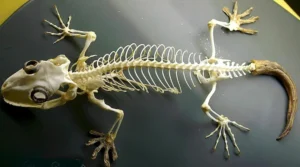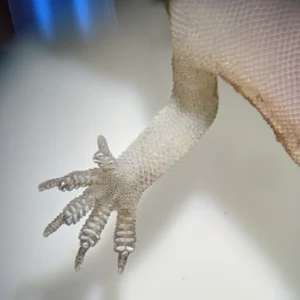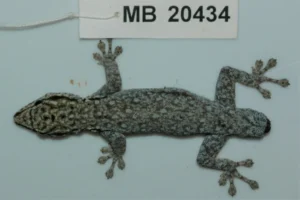It’s late evening, and you’re watching a tiny gecko cling to the wall like it’s stuck with magic. Its little toes grip the surface perfectly, and its body bends in ways you didn’t think were possible. You might think: wait… do geckos even have bones?
Yes, geckos do have bones. They’re reptiles with a complete skeleton inside, made mostly of bone and some cartilage, just like other lizards. Their bones are small and light, built to help them climb, run, and even drop their tail if they need to.
Even though they look soft and squishy, geckos are actually built like tiny little reptiles inside, with skulls, ribs, spines, and limbs; all set up to handle their crazy climbing and twisting moves.
What a Gecko’s Skeleton Looks Like
If you could peek inside a gecko, you’d see a light, detailed frame that holds everything together. Their skeleton isn’t just for support, it’s how they move, climb, and escape from danger.

Like most vertebrates, geckos have:
-
A skull to protect the brain and hold the jaws.
-
A spine that runs from their neck to their tail.
-
Ribs to protect their organs.
-
Limbs and toes with tiny bones that make them super agile.
-
A long tail made of small bones that can break off and grow back.
Even though the bones are small, they’re strong. The bones in their legs and tail let them twist, jump, and hang onto surfaces without falling apart.
If you’ve ever seen a gecko lose its tail, that’s proof their skeleton is real. The tail breaks along pre-set lines between the bones; something only possible if there are bones inside.
How Many Bones Does a Gecko Have?
It depends on the species, but most geckos have about 200 bones. That’s about the same as small mammals.
Each part of the body has a job:
-
Skull bones hold the jaws and sensory organs.
-
Vertebrae make them flexible.
-
Tail bones help with balance, storing fat, and escaping predators.
-
Limb bones let them walk, climb, and jump.
Some bones, especially in the toes, are shaped in amazing ways. Toe bones are flattened a little and support pads that let them stick to walls, glass, and ceilings. It’s a whole movement system hidden under their soft skin.
The Skull: Small but Strong
A gecko’s skull is tiny but surprisingly detailed. Thin plates of bone make the head shape and protect the brain. The skull also holds their big eyes and strong jaw muscles for eating insects.
Geckos don’t have movable eyelids, so the skull has fixed ridges around the eyes. That’s why you often see them licking their own eyeballs. It’s how they clean them.
They also have small ear openings on the sides of the head. In some geckos, you can even see light through one ear hole to the other! The hollow skull keeps them light while staying fast and agile.
The Spine and Tail: A Flexible Design
The spine goes from the neck all the way to the tail tip. It’s made of dozens of small vertebrae that connect but still let them move.
In most geckos, the spine has sections:
-
Neck vertebrae help the head move and twist.
-
Ribs and body vertebrae support the body.
-
Tail vertebrae, make up the tail.
The tail is the coolest part. It has many small bones with natural break points. When a gecko feels scared, it can drop its tail. The tail wriggles on the ground and distracts predators while the gecko gets away.
Later, the tail grows back, but it’s mostly cartilage this time. That makes it bendy but not split into separate bones like the first tail.
Legs, Toes, and That Famous Grip
What really makes geckos amazing is their feet. They can walk upside down, climb glass, and stick to smooth surfaces. It’s not glue or suction, it’s all in the bones and pads of their toes.

Each toe has:
-
Several small bones like your finger bones.
-
Flattened pads underneath, covered with millions of tiny hairs called setae.
The setae branch into even smaller endings that interact with surfaces using weak electrical forces. That means geckos can cling without sticky goo. Their toes just work with physics and their fine bones.
If you’ve seen a gecko pause mid-wall or hang from one toe, that’s their bones and pads working together like a perfect machine.
How Gecko Bones Compare to Other Animals
Geckos share a lot with other animals that have backbones, even us. They have a skull, spine, ribs, legs, and tail.
But gecko bones are:
-
Thinner to stay light for climbing.
-
More flexible to twist and jump.
-
Less dense to make moving easier.
Compare a gecko to a snake or turtle, and you’ll see how evolution used the same skeleton plan in different ways. Snakes have hundreds of vertebrae to bend, turtles have fused ribs for their shells, and geckos changed their bones to climb.
It’s the same blueprint, just changed for their way of life.
How Strong Are Gecko Bones?
Don’t be fooled by their size. Gecko bones are tough. Their legs handle constant climbing, jumping, and landing.
They’re still fragile compared to mammals. If a gecko falls, it might seem like trouble, but they usually land fine. Their bones and muscles work like a shock absorber.
In captivity, geckos can get Metabolic Bone Disease if they don’t get enough calcium or vitamin D3. That softens the bones and can cause weak or bowed legs. Their skeleton depends on good food and sunlight to stay strong.
That’s why reptile keepers talk about calcium powder and UVB light. It keeps their bones healthy.
The Role of Bones in Tail Regrowth
When a gecko loses its tail, the inside changes too. Cells near the cut form a blastema (a bunch of cells that can become new tissues).
These cells rebuild:
-
Muscles
-
Skin
-
Blood vessels
-
Cartilage (instead of bone)
It takes a few weeks. The new tail looks smoother and shorter and doesn’t have separate bones like the first tail.

It’s one of the most interesting things about geckos. Their bones aren’t just for support, they help them survive attacks.
Comparing The Bones of Different Gecko Species
| Species | Habitat | Skeleton Adaptation |
|---|---|---|
| Leopard Gecko (Eublepharis macularius) | Desert | Thicker bones and movable eyelids; strong legs for digging. |
| Crested Gecko (Correlophus ciliatus) | Rainforest | Lighter bones and tail for climbing. |
| Tokay Gecko (Gekko gecko) | Tropical forests | Strong skull and jaws; thick limbs for wall climbing. |
| Day Gecko (Phelsuma madagascariensis) | Trees | Long, thin limbs; flattened toe bones for grip. |
| House Gecko (Hemidactylus frenatus) | Urban walls | Flexible skeleton; tough toes for smooth surfaces. |
They all have the same basic bones, but the size, thickness, and flexibility change depending on where and how they live.
Gecko Bones Through Time
Geckos have been around for over 100 million years, back to the dinosaurs. Some fossils are preserved in amber with tiny bones and even the little hairs on their toes.
Those fossils show geckos already had sticky toe pads millions of years ago. Their bones and pads haven’t changed much because they already worked perfectly.
Why You Don’t See Gecko Bones Easily
Gecko bones are small, bendy, and covered by soft tissue, so you rarely see them unless it’s an X-ray or skeleton display.
Young geckos have bones partly made of cartilage, which later hardens. This lets them bend and squeeze into cracks without breaking.
That’s why geckos can twist their bodies so much. Their skeleton isn’t stiff, it’s flexible armor made for moving easily.
Conclusion
So, do geckos have bones?
Absolutely. Their skeleton is light, flexible, and built cleverly.
From the tiny skull holding their big eyes to the delicate toes letting them walk on walls, every bone helps them stay quick, flexible, and ready for anything.
Their tails can drop, their bodies can twist, and inside, it’s all held together by a tiny but strong skeleton that’s been perfected over millions of years.
Hi, my name is Ezra Mushala, i have been interested animals all my life. I am the main author and editor here at snakeinformer.com.

